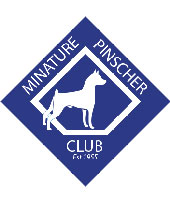About the Miniature Pinscher
Origin
It is believed that the Miniature Pinscher (or Min Pin as he tends to be called) evolved from the ancient German Pinscher family of dogs, which ultimately produced a number of breeds recognised by the Kennel Club today. Originally called the Reh Pinscher as Germans thought he resembled the small red ‘roe’ deer that populated the forests, the Min Pin was a smaller version of the more common middle-sized dog known since the 16th century as the German Smooth Hair Pinscher. In 1836 Dr H G Rinchenbach, a German writer, stated that the Min Pin was the result of a cross between the Dachshund and the Italian Greyhound. The Min Pin was an adept ratter and mouser, and it is believed that the name ‘Pinscher’ was taken from either ‘pincer’ or ‘pincher’ in the English language, referring to the dogs’ tendency to kill vermin quickly by grabbing and holding fast. People nowadays are sometimes mistaken in thinking that the Min Pin is a bred down version of the Doberman. The Min Pin is in fact the older of the two breeds and was recognised as an official breed in Germany several years before the Doberman Pinscher was developed. It was not until 1890 that Louis Doberman bred his first Doberman Pinscher, stating that he wished to breed ‘a giant terrier that would look much like the five pound Reh Pinscher, but that would be fifteen times heavier and larger’. The three pinscher breeds (back to front) The Doberman Pinscher, German Pinscher & Miniature Pinscher (photo Porteous-Thompson)
Appearance
Between 10 and 12″ high at the shoulder blades, the Min Pin is a small and compact dog that is both sturdy and elegant. He has a lustrous smooth short coat and can be red, black and tan, chocolate and tan or blue and tan in colour. A hackney-like gait is a particular characteristic of the breed.
Temperament
The Kennel Club breed standard describes the Min Pin’s temperament as ‘fearless and alert’ and says that ‘he is lively and high-spirited with quick reactions, and has a keen sense of hearing which makes him a good little guard dog’. The Min Pin is certainly an active dog. He likes to be busy and tends to be very curious. This means that it is very important to ensure that you do not leave small objects within reach of your Min Pin (and never underestimate the lengths he may go to to get hold of something he has his eye on!). It is essential to ensure that your garden is secure with no small gaps in or under fences. Also take great care when opening doors or windows as your Min Pin can slip through in a flash. He enjoys going out for walks, although a coat may be a good idea in cold weather. He should always be taken out on a lead until he has been trained to return to you on command and therefore an extending lead can prove to be a useful purchase. The Min Pin is bright and intelligent and some people have enjoyed considerable success with their Min Pins at both obedience and agility. He does have a mind of his own, however, so a patient and persistent trainer is essential! A Min Pin can make a delightful companion for an adult or child as long as he is treated with respect. Children must not be allowed to grab at him, hit him or treat him roughly in any way. A full-grown Min Pin is still a very small dog and while he can bounce around from sofa to chair to floor with ease, dropping him from the same sofa could well result in injury.
Feeding
Care and Maintenance The breeder from whom you purchase your puppy will give you a supply of the food your puppy has been eating with specific instructions on how much to feed him. Any transition to another food type should be done gradually to avoid upsetting his stomach. The Min Pin’s smart appearance is easy to maintain. Toenails need to be trimmed every couple of weeks to prevent them from growing too long. Eyes and ears should be wiped regularly with a cotton wool pad dampened in warm water and cleaning his teeth on a regular basis is a discipline to be encouraged. While the occasional bath does him no harm, bathing him too regularly may dry his coat out. Instead brushing him regularly and wiping his coat with a damp cloth will keep his coat clean and shiny.
Breeding
Breeding is certainly not to be taken lightly. Contrary to popular belief, it’s not a moneymaker and can, in fact, be a costly business. It requires a great deal of thought from selecting the right stud dog through to finding the right homes for the puppies. If this is an avenue you want to pursue, contact the breeder from whom you purchased your Min Pin for advice.
